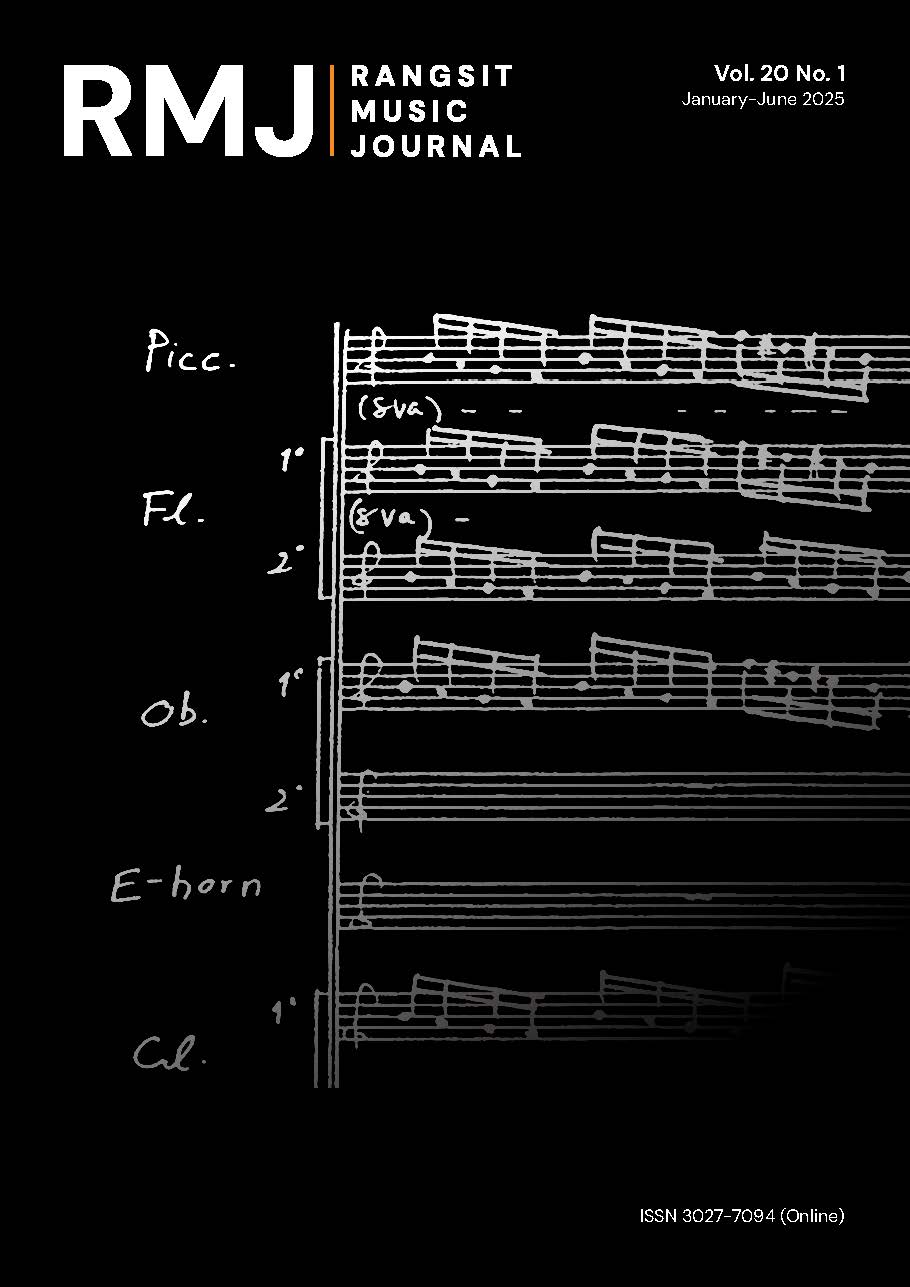ประวัติโดยสังเขปของเลเฟวย์ ลิน ปิง จอนสดอตตีร์ และการวิเคราะห์บทเพลง “From The Start”
DOI:
https://doi.org/10.59796/rmj.V20N1.2025.A0101คำสำคัญ:
ดนตรีสมัยนิยม, ดนตรีแจ๊ส, การวิเคราะห์ดนตรีบทคัดย่อ
บทความวิชาการฉบับนี้เป็นการนำเสนอประวัติของเลเฟวย์ ลิน ปิง จอนสดอตตีร์ โดยสังเขปและการวิเคราะห์บทเพลง From The Start เพื่อให้เห็นถึงเอกลักษณ์เฉพาะตัวของศิลปินโมเดิร์นแจ๊สหรือสมัยนิยมในปัจจุบัน โดยเนื้อหาหลักมุ่งเน้นไปที่การวิเคราะห์บทเพลง From The Start จากอัลบั้ม Bewitched ที่มีการเผยแพร่ในปี ค.ศ. 2023 ซึ่งหัวข้อในการวิเคราะห์บทเพลงจะเลือกเฉพาะประเด็นสำคัญดังนี้ 1) สังคีตลักษณ์ 2) การดำเนินคอร์ด 3) ตัวอย่างการใช้รูปแบบจังหวะเพื่อขับเคลื่อนบทเพลงของแนวเสียงร้อง แนวเสียงกีตาร์ แนวเสียงเปียโน แนวเสียงเบสและกลอง
โดยกระบวนการรวบรวมข้อมูลเพื่อเขียนบทความใช้วิธีการศึกษาจากโน้ตของฉบับย่อที่บันทึกโน้ตเฉพาะแนวทำนอง คำร้อง และ คอร์ด ที่มีการเผยแพร่อย่างเป็นทางการบนเว็บไซต์ของเลเฟวย์ จากนั้นผู้เขียนได้ทำการถอดความทางดนตรีจากช่องทางออนไลน์ ได้แก่ แอปพลิเคชัน Spotify และ เว็บไซต์ Youtube ในช่องของเลเฟวย์ที่ใช้เผยแพร่ผลงานอย่างเป็นทางการ เพื่อเป็นการตรวจสอบข้อมูลและประมวลผลว่าจะเลือกประเด็นใดในการวิเคราะห์เขียนบทความ ซึ่งการบันทึกโน้ตจากการถอดความทางดนตรีของผู้เขียนอาจมีข้อผิดพลาดเล็กน้อยเกิดขึ้น แต่ไม่ส่งผลต่อประเด็นหลักของบทความที่ผู้เขียนต้องการนำเสนอ เมื่อผู้เขียนได้ข้อมูลจากทั้งสองกระบวนการที่ได้กล่าวไปนั้น ผู้เขียนจึงได้ทำการค้นคว้าจากหนังสือ ตำรา และบทความที่มีประเด็นเกี่ยวข้องเพื่อหาทฤษฎีและหลักการรองรับประเด็นของบทความวิชาการฉบับนี้
ผลการวิเคราะห์พบว่า สังคีตลักษณ์ของบทเพลง From The Start มีลักษณะแบบ AAB มีท่อนเกริ่นนำ จำนวน 2 ห้องบนอัตราจังหวะ 4/4 และท่อนปิด จำนวน 4 ห้องบนอัตราจังหวะ 4/4 จึงทำให้ผู้ฟังสามารถเข้าใจลักษณะของบทเพลงได้ง่าย อีกทั้งการดำเนินคอร์ดที่ใช้คอร์ดพื้นฐานในลักษณะคอร์ดนำโดมินันท์-คอร์ดโดมินันท์-คอร์ดโทนิก ในกุญแจเสียง Db Major เป็นส่วนใหญ่ที่ประกอบด้วยเสียงเทนชันซ้อนกันหลากหลายรูปแบบ รวมถึงรูปแบบจังหวะของแต่ละแนวทำนองที่มีความสลับซับซ้อน บนพื้นฐานของอัตราจังหวะ 4/4 ซึ่งทำให้ภาพรวมของบทเพลงมีการเคลื่อนไหวที่ราบลื่นและมีมิติของเสียงที่หลากหลาย จากการวิเคราะห์บทเพลง From The Start ในบริบทที่กว้างขึ้น ทำให้เห็นการเปลี่ยนแปลงของดนตรีสมัยนิยมในยุคสมัยใหม่ได้อย่างชัดเจน ผู้เขียนมีข้อสังเกตเกี่ยวกับดนตรีสมัยนิยมในยุคสมัยใหม่ที่มีลักษณะเด่นชัดในเรื่องการผสมผสานวัฒนธรรมดนตรีที่มีความหลากหลายเข้าด้วยกัน ช่วยให้เกิดการสร้างสรรค์บทเพลงที่มีเอกลักษณ์เฉพาะตัว โดยรายละเอียดทางดนตรีที่มีความสลับซับซ้อนล้วนมีบทบาทสำคัญในแสดงให้เห็นถึงอัตลักษณ์ของศิลปิน ผลงานของเลเฟวย์รวมถึงบทเพลง From The Start เป็นตัวอย่างที่ดีของการผสมผสานวัฒนธรรมดนตรี ที่สามารถสร้างบทเพลงให้มีความรู้สึกใหม่ สดใส และแสดงให้เห็นถึงรากฐานของประเพณีของดนตรีที่เลือกนำมาผสมผสานได้อย่างชัดเจน
หนึ่งในอิทธิพลที่สำคัญต่อดนตรีสมัยนิยมในยุคสมัยใหม่ที่สะท้อนอยู่ในบทเพลง From The Start คืออิทธิพลของวัฒนธรรมดนตรีอเมริกันที่มีการแพร่หลายในทุกสังคมทั่วโลก อิทธิพลนี้เห็นได้ชัดในการใช้วิธีการเลือกใช้เสียงประสาน ที่ได้รับอิทธิพลจากดนตรีแจ๊ส โดยเฉพาะการใช้คอร์ดแบบขยาย ที่มีการเพิ่มโน้ตเข้ามาเพื่อเสริมสร้างสีสันบนคอร์ดที่เป็นพื้นฐาน ซึ่งเลือกใช้การเลือกเสียงประสานในลักษณะนี้ทำให้บทเพลงมีความสลับซับซ้อนและลึกซึ้งมากยิ่งขึ้น นอกจากนี้การจัดการเสียงประสานในบทเพลงยังสะท้อนถึงให้ถึงอัตลักษณ์ของดนตรีคลาสสิก ด้วยการจัดแนวทำนองของแต่ละแนวเสียงให้เคลื่อนไหวที่สอดคล้องและราบลื่นกับการเปลี่ยนแปลงของคอร์ด ทำให้บทเพลงมีความไหลลื่นและกลมกลืน ซึ่งแสดงให้เห็นถึงความสามารถของเลเฟวย์ที่สามารถบูรณาการองค์ความรู้ทางด้านดนตรีได้เป็นอย่างดี การผสมผสานอัตลักษณ์ระหว่างดนตรีแจ๊สและดนตรีคลาสสิกเข้าด้วยกันนี้ไม่เพียงแต่เพิ่มเสน่ห์ให้กับบทเพลง แต่ยังทำให้บทเพลงนี้เป็นผลงานที่เชื่อมโยงให้เห็นถึงอัตลักษณ์ทางดนตรีของแต่ละยุคสมัยได้อย่างชัดเจน
นอกจากองค์ประกอบทางเสียงประสานและโครงสร้างแล้วบทเพลง From The Start ยังมีความโดดเด่นในเรื่องของความซับซ้อนทางจังหวะ การเกิดขึ้นของรูปแบบจังหวะที่อยู่ในแนวเสียงร้อง กีตาร์ เปียโน ดับเบิลเบส และกลอง ช่วยเพิ่มความสลับซับซ้อนให้กับบทเพลง ด้วยการใช้รูปแบบจังหวะเหล่านี้ทำให้บทเพลงเคลื่อนไหวบนจังหวะหลัก 4/4 แต่ฟังแล้วมีรายละเอียดปลีกย่อยสอดแทรกอย่างสม่ำเสมอ ด้วยการเปลี่ยนแปลงรูปแบบจังหวะและการใช้จังหวะขัด ที่ช่วยดึงดูดความสนใจของผู้ฟัง การผสมผสานรูปแบบจังหวะขัดและความคิดสร้างสรรค์นี้เป็นตัวอย่างของการสร้างบทเพลงที่มีความละเอียดลออ ซึ่งเป็นลักษณะเฉพาะของดนตรีของเลเฟวย์
จากมุมมองของผู้เขียน การผสมผสานของวัฒนธรรมดนตรีที่มีความหลากหลายเข้าด้วยกันมีอิทธิพลต่อการประพันธ์ดนตรีในยุคสมัยใหม่อย่างเห็นได้ชัด การบูรณาการสิ่งเหล่านี้มีเริ่มความชัดเจนมากขึ้นเรื่อย ๆ และมีส่วนทำให้ดนตรีแต่ละประเภทได้แสดงอัตลักษณ์ได้ชัดเจนมากขึ้น ผลงานดนตรีในยุคสมัยใหม่จึงโดดเด่นด้วยรายละเอียดทางดนตรีที่สลับซับซ้อน จากการที่ศิลปินนำเสนอผ่านการจัดเรียบเรียง การออกแบบ และการสังเคราะห์ ซึ่งทำให้ศิลปินได้แสดงออกถึงความเป็นตัวตนของตนเองภายใต้กรอบของดนตรีสมัยนิยม
การที่วัฒนธรรมดนตรีอเมริกันมีอิทธิพลอย่างชัดเจนต่อดนตรีป็อปทั่วโลก ทั้งทางตรงและทางอ้อมนั้นเป็นสิ่งที่ไม่สามารถปฏิเสธได้ กรณีบทเพลง From The Start เป็นตัวอย่างของการผสมผสานทางดนตรีที่ลงตัว ด้วยการใช้คอร์ดแบบขยายที่เพิ่มโน้ตเข้าเสริมสร้างสีสันบนคอร์ดพื้นฐานทำให้เห็นได้ชัดถึงอิทธิพลของแจ๊ส ส่วนหลักการดนตรีคลาสสิกยังคงมีอิทธิพลต่อการจัดระเบียบเสียงประสานในบทเพลง โดยทำให้การเปลี่ยนแปลงคอร์ดมีความลื่นไหลผ่านการจัดการเสียงที่ละเอียด นอกจากนี้การสอดคล้องของแนวทำนองและจังหวะที่ซับซ้อนยังเพิ่มความลึกซึ้งให้กับเพลง
ดังนั้นบทเพลง From The Start เป็นผลงานที่แสดงออกถึงเอกลักษณ์ทางดนตรีที่ชัดเจน แม้ว่าผลงานจะฟังดูเรียบง่าย แต่ก็ประกอบด้วยรายละเอียดทางดนตรีที่มีความสลับซับซ้อน ซึ่งทำให้บทเพลงมีความสมดุลที่ดีระหว่างความซับซ้อนและความเรียบง่ายเข้าถึงได้ การสร้างสรรค์ดนตรีสมัยนิยมที่มีคุณภาพในยุคสมัยปัจจุบันนั้น ต้องอาศัยความรู้ทางดนตรีที่หลากหลาย รวมถึงทักษะในการแสดงและความเข้าใจทางทฤษฎีดนตรี ซึ่งทั้งสององค์ประกอบนี้ล้วนเป็นสิ่งสำคัญในการกำหนดทิศทางและคุณภาพโดยรวมของการสร้างผลงานทางดนตรี รายละเอียดที่สลับซับซ้อนในแต่ละชิ้นงานเป็นการสะท้อนถึงความเป็นเอกลักษณ์ คุณภาพ และความโดดเด่นของงานนั้น ๆ
ความสามารถในด้านการจัดการและปรับแต่งรายละเอียดขององค์ประกอบทางดนตรีให้สอดคล้องกับอัตลักษณ์ของศิลปิน ถือเป็นการกำหนดความเป็นตัวตนของศิลปินผู้นั้น โดยรายละเอียดทางดนตรีไม่ได้ถูกกำหนดด้วยความสลับซับซ้อนทางด้านเทคนิคเพียงอย่างเดียว แต่ยังต้องอาศัยผลลัพธ์ด้านสุนทรียศาสตร์และความสวยงามโดยรวมของผลงานที่ได้สร้างสรรค์ขึ้น ซึ่งสมดุลระหว่างทักษะความคิดสร้างสรรค์และความเป็นศิลปินคือสิ่งที่กำหนดเอกลักษณ์และอิทธิพลของผลงานดนตรี
เอกสารอ้างอิง
Cheung, Catharina. “Laufey on Love and Naivete, Childhood Hong Kong Memories, and V from BTS.” Accessed January 15, 2024. https://www.timeout.com/hong-kong/music/laufey-on-love-and-naivete-childhood-hong-kong-memories-and-v-from-bts.
Jaffe, Andy. Jazz Harmony. 2nd ed. Tübingen: TC Druck, 1996.
Kent, Matthew. “On the Rise Laufey.” Accessed January 8, 2024. https://www.thelineofbestfit.com/features/interviews/laufey-on-the-rise.
Laohverapanich, Teerus. Jazz Styles and Analysis. Bangkok: Phatcharada Press, 2021. (in Thai)
Laohverapanich, Teerus. Jazz Theory and Improvisation 1. 3rd ed. Bangkok: Phatcharada Press, 2021. (in Thai)
Laohverapanich, Teerus. Jazz Theory and Improvisation 2. Bangkok: Phatcharada Press, 2022. (in Thai)
Laufeymusic.com. “Learn to Play Bewitched.” Accessed January 8, 2024. https://www.laufeymusic.com/bewitchedsheetmusic.
Pease, Ted, and Ken Pullig. Modern Jazz Voicings: Arranging for Small and Medium Ensembles. Boston: Berklee Press, 2001.
Rawlins, Robert, and Nor Eddine Bahha. Jazzology: The Encyclopedia of Jazz Theory for all Musicians. Milwaukee, Wl: Hal Leonard Corporation, 2005.
Trakulhun, Wiboon. Western Music Theory. 3rd ed. Pathumthani: Anantanak, 2021. (in Thai)
Vandemoortele, Peter. “Root Motion Analysis of Chord Progressions of Selected Jazz Compositions Written Between 1980 and 2000.” Rangsit Music Journal 15, 1 (2020): 165-177. https://so06.tci-thaijo.org/index.php/rmj/article/view/190513/162188.
ดาวน์โหลด
เผยแพร่แล้ว
รูปแบบการอ้างอิง
ฉบับ
ประเภทบทความ
สัญญาอนุญาต
ลิขสิทธิ์ (c) 2025 วารสารดนตรีรังสิต

อนุญาตภายใต้เงื่อนไข Creative Commons Attribution-NonCommercial-NoDerivatives 4.0 International License.







